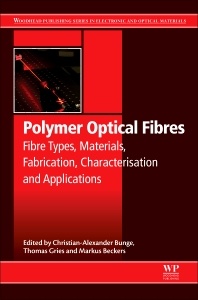Description
Polymer Optical Fibres
Fibre Types, Materials, Fabrication, Characterisation and Applications
Woodhead Publishing Series in Electronic and Optical Materials Series
Coordinators: Bunge Christian-Alexander, Beckers Markus, Gries Thomas
Language: English
Subjects for Polymer Optical Fibres:
Keywords
Ageing mechanisms; Automotive; Batch extrusion; Bio-sensor; Braided fabric; Chemical analysis; Chemical properties; Chromatic dispersion; Co-extrusion; Communication; Continuous extrusion; Data transmission; Design; Dispersion; Dry-spinning; Fibre Bragg grating; Fibre gratings; Glass optical fibres; Glass-optical fibres; Heat drawing; Illumination; Imaging fibres; Industrial; Kelvin�Voigt model; Knitted fabric; Laser diode; Light-emitting diode; Lighting; Manufacturing process; Manufacturing; Market analysis; Materials; Maxwell equations; Maxwell model; Medical; Melt spinning; Microstructured POFs; Mie scattering; Military; Mode-coupling; Modulation; Multi non-crimp; Numerical aperture; Optical receiver; Optical transmitter; Photochemical polymerization; Photodiode; POF applications; Polymer-optical fibre; Polymer-optical fibres; Preform production.Burgers model; Rayleigh scattering; Refractive-index; Sensor; Side-emitting POFs; Smart textiles; Step-index POFs; Stress�strain; Structure; Textiles; Thermoplastic polymer; Total reflection; Tubular fibres; Wave equations; Wave theory; Weibull plot; Woven fabric; Zener model
436 p. · 15x22.8 cm · Hardback
Description
/li>Contents
/li>Biography
/li>Comment
/li>
Polymer Optical Fibres: Fibre Types, Materials, Fabrication, Characterization, and Applications explores polymer optical fibers, specifically their materials, fabrication, characterization, measurement techniques, and applications. Optical effects, including light propagation, degrading effects of attenuation, scattering, and dispersion, are explained. Other important parameters like mechanical strength, operating temperatures, and processability are also described. Polymer optical fibers (POF) have a number of advantages over glass fibers, such as low cost, flexibility, low weight, electromagnetic immunity, good bandwidth, simple installation, and mechanical stability.
1. Introduction – why we made this book
2. Basics of light guidance
3. Basic principles of optical fibres
4. Special fibres and components
5. Materials, chemical properties and analysis
6. Fabrication techniques for polymer optical fibres
7. Mechanical properties of polymer-optical fibres
8. Polymer-optical fibres for data transmission
9. Applications of polymer-optical fibres in sensor technology, lighting and further applications
10. Polymer-optical fibre (POF) integration into textile fabric structures
11. Overview of the POF market
Mr Markus Beckers works in the ITA. RWTH Aachen is ranked no. 1 University for technology in Germany and ITA is in a top international position in polymer fibre production and application research. It specialises in process upscaling and product development close to market.
Thomas Gries is Professor and Director of the Institut für Textiltechnik of RWTH Aachen University, Germany. His achievements are commendable, and his contributions to the field of textile technology and fibre based composites have had a profound impact. Furthermore, his leadership in transforming the Institut für Textiltechnik into a comprehensive provider of textile innovation, digitalisation and sustainability initiatives underscores his dedication to pushing the boundaries of textile technology. His involvement in textile recycling, decarbonisation, biotransformation and efforts to enhance energy and material efficiency further solidifies his status as an undisputed leader in the field.
Contact e-mail: thomas.gries@ita.rwth-aachen.de
- Provides systematic and comprehensive coverage of materials, fabrication, properties, measurement techniques, and applications of POF
- Focuses on industry needs in communication, illumination and sensors, the automotive industry, and medical and biotechnology
- Features input from leading experts in POF technology, with experience spanning optoelectronics, polymer, and textiles
- Explains optical effects, including light propagation, degrading effects of attenuation, scattering, and dispersion




